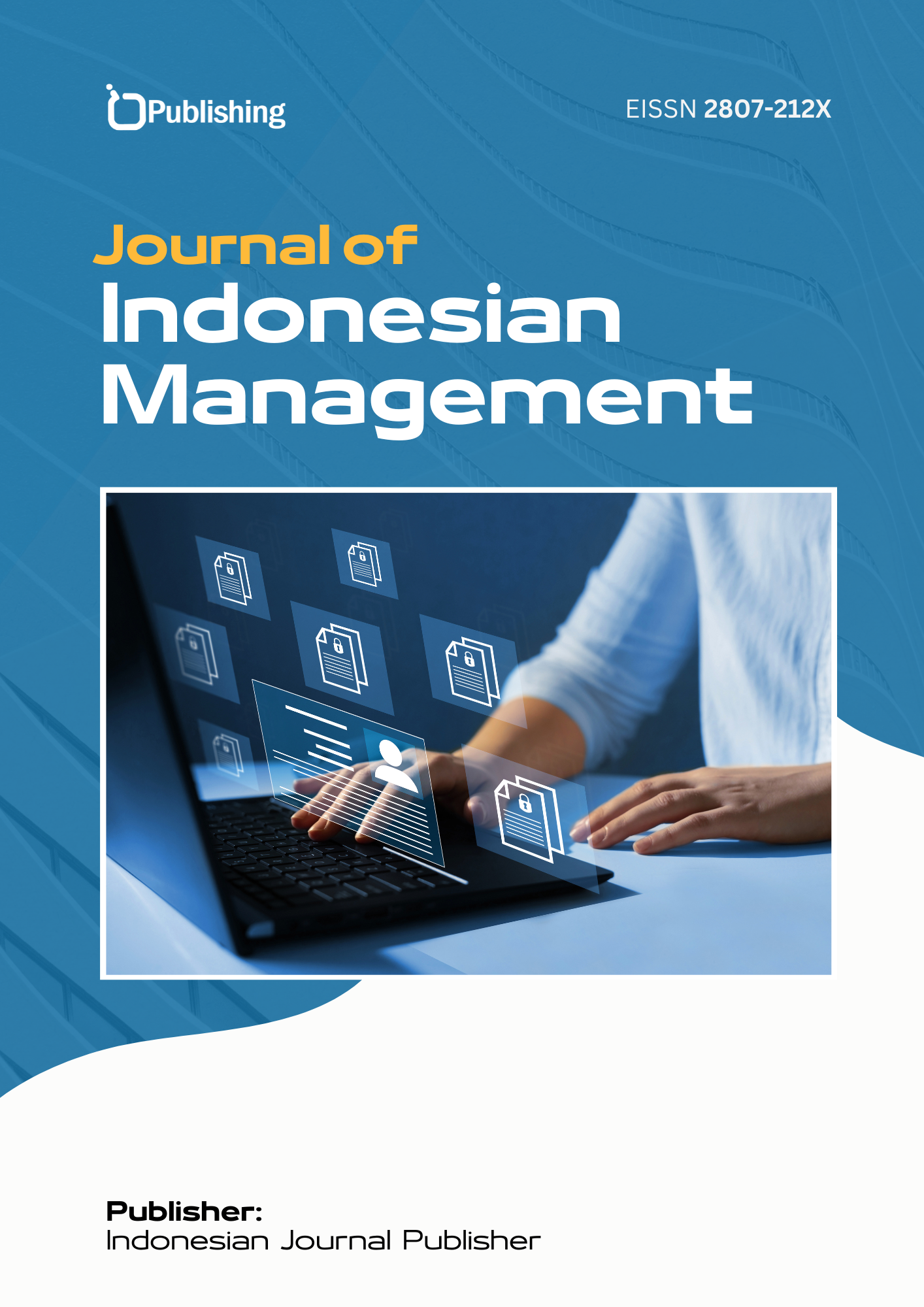Implementasi Kerangka Keamanan NIST Dan ISO/IEC 27001 Dalam Menghadapi Ancaman Risiko Siber
DOI:
https://doi.org/10.53697/jim.v4i4.1973Keywords:
Manajemen Risiko, Keamanan, Informasi, ISO/IEC 27001, NIST, SIBERAbstract
Artikel ini memberikan gambaran komprehensif mengenai implementasi kerangka kerja keamanan dari NIST dan standar internasional ISO/IEC 27001 untuk memperkuat keamanan siber organisasi di era digital. Dengan ancaman risiko siber yang terus meningkat, kebutuhan akan sistem keamanan yang andal menjadi sangat mendesak bagi organisasi dari berbagai sektor. Penelitian ini berfokus pada identifikasi aset-aset penting organisasi yang rentan terhadap serangan, analisis terhadap berbagai jenis kerentanan yang mungkin timbul, serta penentuan jenis-jenis ancaman yang dihadapi. Selain itu, penelitian ini mengusulkan kebijakan dan prosedur mitigasi yang dirancang untuk meningkatkan kontrol dan respons keamanan informasi. Melalui studi komparatif dan analisis mendalam, artikel ini mengkaji efektivitas standar NIST dan ISO/IEC 27001 dalam memandu proses identifikasi, penilaian, dan pengelolaan risiko keamanan informasi. Penerapan standar internasional ini memberikan manfaat penting, seperti peningkatan kesadaran akan pentingnya keamanan informasi di kalangan staf dan mahasiswa, penguatan tata kelola keamanan informasi, dan pengembangan strategi mitigasi yang lebih komprehensif. Dengan demikian, artikel ini dapat membangun fondasi keamanan siber yang kokoh sehingga dapat membantu organisasi menghadapi kompleksitas ancaman siber di era digital seperti saat ini.
References
Amin, M. (2014). Pengukuran Tingkat Kesadaran Keamanan Informasi Menggunakan Multiple Criteria Decision Analysis (Mcda). Jurnal Penelitian Dan Pengembangan Komunikasi Dan Informatika, 5(1), 15–24.
Apriany, A., Wibowo, A., Manajemen, S., Informasi, K., & Risiko, M. (2022). Analysis of the Implementation of ISO 27001: 2022 and KAMI Index in Enhancing the Information Security Management System in Consulting Firms 1,2.
Farismana, R., & Pramadhana, D. (2022). Manajemen Risiko pada Sistem Informasi Ujian Akhir Semester Menggunakan Metode NIST 800-30 (Studi Kasus SMKN 2 Baleendah). Jurnal Ilmu Komputer An Nuur, 2, 21–27.
Fenny Anita, & Tanujaya, K. (2023). Pengaruh Kejahatan Siber Terhadap Kinerja Organisasi Dengan Moderasi Kesadaran Keamanan Informasi. Jurnal Ekuilnomi, 5(2), 266–275. https://doi.org/10.36985/ekuilnomi.v5i2.743
Fitrani, L. D. (2022). Risk Risk Assessment and Development of Access Control Information Security Governance Based on ISO/IEC 27001:2013 At XYZ University. JATISI (Jurnal Teknik Informatika Dan Sistem Informasi), 9(2), 891–907. https://doi.org/10.35957/jatisi.v9i2.1643
Herdiana, Y., Munawar, Z., & Indah Putri, N. (2021). Mitigasi Ancaman Resiko Keamanan Siber Di Masa Pandemi Covid-19. Jurnal ICT : Information Communication & Technology, 20(1), 42–52. https://doi.org/10.36054/jict-ikmi.v20i1.305
Lana, A. (2021). Dampak Kejahatan Siber Terhadap Teknologi Informasi Dan Pengendalian Internal. Sosial Dan Pendidikan, 1(3), 1–13.
Moore, T. (2024). The NIST Cybersecurity. 32. https://nvlpubs.nist.gov/nistpubs/CSWP/NIST.CSWP.29.pdf
Soesanto, E., Saputra, F., Puspitasari, D., & Danaya, B. P. (2023). Determinasi Sistem Manajemen Sekuriti: Analisis Objek Vital, Pengamanan File dan Pengamanan Cyber pada Yayasan Siber Publisher. Jurnal Ilmu Multidisplin, 2(1), 23–29. https://doi.org/10.38035/jim.v2i1.221
Whitman, M. E., & Mattord, H. J. (2011). Principles of Information Security Fourth Edition. Learning, 269, 289.
Chen, Y. (2017). Short-term electrical load forecasting using the Support Vector Regression (SVR) model to calculate the demand response baseline for office buildings. Applied Energy, 195, 659–670. https://doi.org/10.1016/j.apenergy.2017.03.034
Coates, A. S. (2015). Tailoring therapies-improving the management of early breast cancer: St Gallen International Expert Consensus on the Primary Therapy of Early Breast Cancer 2015. Annals of Oncology, 26(8), 1533–1546. https://doi.org/10.1093/annonc/mdv221
Goodwin, G. M. (2016). Evidence-based guidelines for treating bipolar disorder: Revised third edition recommendations from the British Association for Psychopharmacology. Journal of Psychopharmacology, 30(6), 495–553. https://doi.org/10.1177/0269881116636545
Kumar, S. (2017). Review of Childhood Obesity: From Epidemiology, Etiology, and Comorbidities to Clinical Assessment and Treatment. Mayo Clinic Proceedings, 92(2), 251–265. https://doi.org/10.1016/j.mayocp.2016.09.017
Kusumoto, F. M. (2017). 2017 HRS expert consensus statement on cardiovascular implantable electronic device lead management and extraction. Heart Rhythm, 14(12). https://doi.org/10.1016/j.hrthm.2017.09.001
LeBoff, M. S. (2022). The clinician’s guide to prevention and treatment of osteoporosis. Osteoporosis International, 33(10), 2049–2102. https://doi.org/10.1007/s00198-021-05900-y
Lucendo, A. J. (2017). Guidelines on eosinophilic esophagitis: evidence-based statements and recommendations for diagnosis and management in children and adults. United European Gastroenterology Journal, 5(3), 335–358. https://doi.org/10.1177/2050640616689525
Malhi, G. S. (2015). Royal Australian and New Zealand College of Psychiatrists clinical practice guidelines for mood disorders. Australian and New Zealand Journal of Psychiatry, 49(12), 1087–1206. https://doi.org/10.1177/0004867415617657
Ruemmele, F. M. (2014). Consensus guidelines of ECCO/ESPGHAN on the medical management of pediatric Crohn’s disease. Journal of Crohn’s and Colitis, 8(10), 1179–1207. https://doi.org/10.1016/j.crohns.2014.04.005
Ruggiero, S. L. (2014). American association of oral and maxillofacial surgeons position paper on medication-related osteonecrosis of the jaw - 2014 update. Journal of Oral and Maxillofacial Surgery, 72(10), 1938–1956. https://doi.org/10.1016/j.joms.2014.04.031
Safford, B. (2015). Use of an aggregate exposure model to estimate consumer exposure to fragrance ingredients in personal care and cosmetic products. Regulatory Toxicology and Pharmacology, 72(3), 673–682. https://doi.org/10.1016/j.yrtph.2015.05.017
Scheen, A. (2015). Pharmacodynamics, efficacy and safety of sodium-glucose co-transporter type 2 (SGLT2) inhibitors for the treatment of type 2 diabetes mellitus. Drugs, 75(1), 33–59. https://doi.org/10.1007/s40265-014-0337-y
Watts, N. (2018). The 2018 report of the Lancet Countdown on health and climate change: shaping the health of nations for centuries to come. The Lancet, 392(10163), 2479–2514. https://doi.org/10.1016/S0140-6736(18)32594-7
Downloads
Published
How to Cite
Issue
Section
License
Copyright (c) 2024 Nadyfa Ramadhanty

This work is licensed under a Creative Commons Attribution 4.0 International License.













